When planning our kitchen remodel, we wanted to continue our cozy, white, coastal cottage theme in the kitchen as well. We planned for light or white colored cabinets and to save a few bucks, we planned to purchase them from Ikea. Little did we know, to get the look we were after, we would be painting the cabinet doors.
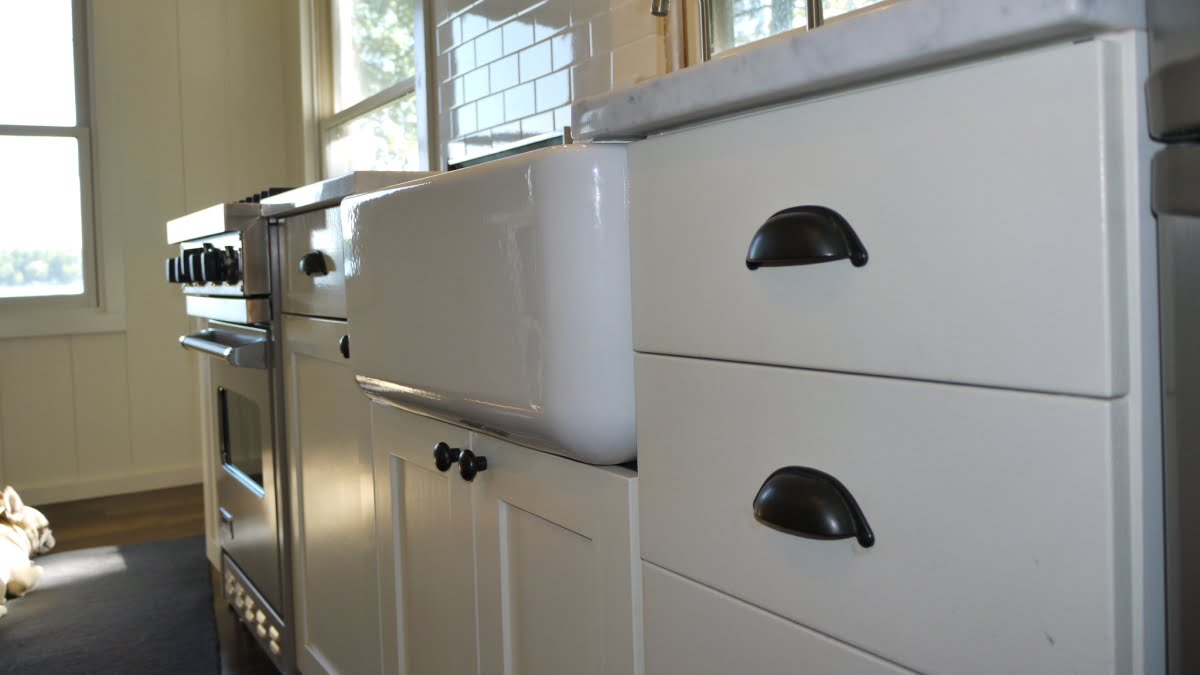
Give your kitchen cabinets a facelift by painting them
Buying cabinets and cabinet doors from Ikea has some limitations. The cabinet boxes are offered only in white or dark brown, and the door finished are fairly limited. When we were looking, we didn’t find and cabinet doors in white that we liked. All of the white doors were simple, glossy and either made from covered fiberboard or synthetic resin. Yuck.
We wanted something a bit more traditional and something wood. And we were hoping these traditional wood doors would be a lighter, preferably white, color.
So what to do? We decided to buy the stock white Ikea cabinet boxes and the dark brown Ikea Tidaholm cabinet doors with the plan to paint them white. Painting brand new kitchen cabinets did not seem ideal, but, if the results were less than spectacular, well, it’s just the cabin and they are just Ikea cabinets.
Fortunately, painting the cabinet doors was fairly straightforward, and the results were fantastic.

To match our interior walls, we painted the cabinet doors with Benjamin Moore’s Satin Impervo paint in White Chocolate.
Our finished painted Ikea cabinets perfectly matched our interior, and the soft, matte finish of the paint added depth and character to cabinet doors.

The method we used to paint the cabinets was simple — spray can primer and brush applied oil finish.
You can certainly have them professionally sprayed if you would rather not do this yourself. But, by taking your time, using high-quality paint and a few tricks, you can do it yourself and obtain a very high quality, professional finish for your cabinet doors.
Read on for a walk through the steps describing how we painted our Ikea oak kitchen cabinet doors. We just painted the doors, but you can certainly paint the cabinet boxes as well. If you are planning on painting your entire cabinet, remove the doors and paint them as below, and paint the cabinet enclosures in place using the same techniques, and allowing to dry prior to re-attaching the newly painted cabinet doors.
OVERVIEW | Paint Your Kitchen Cabinets
SUPPLIES LIST | Paint Your Kitchen Cabinets
TOOLS LIST | Paint Your Kitchen Cabinets
STEPS | Paint Your Kitchen Cabinets
- Pick a quiet, clean spot to work
Set up a clean work area to paint the cabinets. The location should have a table or similar to allow you to spread out the cabinet doors and should be relatively free of dust and debris that could compromise the finish of the paint.
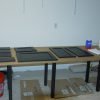

- Thoroughly clean the work space
Create a dust-free environment by cleaning and vacuuming the floor, walls, table and surrounding areas. Cover the table surface with newspaper, drop cloth, cardboard or other covering to prevent damage from paint over spray and drips.
- Assemble required supplies, tools and paint
Gather your prep materials including a sanding block, rags, tack cloth, a primer paint and a finish coat paint.
I used an alcohol (shellac) based primer, Zinsser® B-I-N. This primer is great for its fast drying, high coverage qualities. High coverage primers (a.k.a stain blocking primers) work well in this setting as they have high levels of solids and act as filler over the painted surface, and leveling with light, fine sanding to produce a smooth surface.Also, the alcohol-base of this produce, provides excellent “bite” and adhesion.
For a finish paint, choose a paint designed for interior use on wood doors and trim. Some paints are actually labeled for cabinet painting. Enamel alkyd paints work well, especially the older oil-based ones (like Satin Impervo!). Unfortunately these paints off-gas solvents and are bad for the environment and are being phased out of use. Newer paint technology offers water suspended alkyd paints that are getting better over time. These newer paints tend to be more difficult to use compared with the older oil products.
The secret sauce of this project was the paint additive Penetrol® by Flood/PPG. This product acts as a paint conditioner, altering its characteristics to improve the flow and leveling of the paint. With the improved paint surface leveling, you should be able to apply your finish coat with a brush without brush marks on the finished paint surface.
There is a version of the product for latex based paints too. I’ve used it for interior doors painted with latex paint and it seems to work well.
If using one of the newer water-suspended alkyd paints, I would check with the manufacturer regarding compatibility. I would also trial the mixture on a test surface prior to using it on your cabinets.
Anyway, if you can get your hands on some Benjamin Moore Impervo, or similar, awesome, use it. If not, ask your paint store for suggestions and consider a trial piece of material to test the paint you choose and to gain experience applying it.

- Remove cabinet doors and arrange on work table
If painting existing, in place cabinets and doors, remove and paint the doors first. Prior to removing doors, mark the doors in a hidden area (back) and make a diagram of there location before removal. Save hardware in zip lock bags or similar for reassembly. Move doors to work area.
- Prep cabinet doors by lightly sanding and cleaning
Using a medium to fine sanding sponge or similar (I used a 3M fine grit sanding sponge), and working in the direction of the wood grain, sand the surfaces of the cabinets. Use care not to round off edges when sanding.
If the cabinet doors you are painting are not new, be sure to thoroughly clean the surface of the doors prior to sanding. Use a solvent based de-greaser if the cabinet doors have been in service for some time, as kitchen cabinet doors tend to accumulate oily deposits.
Use an alcohol dampened microfiber cloth to wipe away residue sanding dust. Finish the cleaning process with a clean tack cloth.

- Apply primer paint coat
Prior to painting, vacuum the work space and work surfaces to remove residual dust from the sanding process. Once the work area is clean, arrange the clean, sanded cabinet doors for the first primer coat of paint.
For primer application I found using spray can formulation of the Zinsser BIN primer to provided easier application and better results compared to brush application. As always, with spray applications of paint, it is preferable to apply several lighter coats of paint rather than one heavy coat. Use a mask or respirator when spray painting.
Spray one side at a time, allow to dry for one hour, and then spray the opposite side. Once both sides of the cabinet doors are primed, allow the doors to dry overnight before applying a second coat.
- Apply second primer paint coat
After drying overnight, lightly sand the primed cabinet doors to remove any high primer spots. After sanding, used an alcohol dampened microfiber cloth to remove sanding dust and finish the clean up with a tack cloth to remove any residual dust.
Next, apply a second coat of primer to the cabinet doors, allowing each side to dry for an hour before painting the next. Once the cabinet doors have a second coat of primer, allow the doors to again to dry overnight. After drying, again lightly sanded the primer and clean with an alcohol dampened microfiber cloth and a dry tack cloth before beginning the finish coat.


- Apply finish paint coat
For the finish, I used Benjamin Moore’s Satin Impervo Alkyd low-luster paint. This paint is expensive ($75 + / gallon), but it is an exceptional paint that has excellent leveling qualities. Beware that this is an oil based product and lighter colors of this paint may yellow with time.
Prior to applying the finish coat, I added the paint additive Penetrol to help provide a smooth finish without brush marks. Penetrol is a petroleum based solvent that when added to oil based paints lengthens drying time and helps level the finish.
To keep the finish paint “stock”, I only added Penetrol to individual small batches mixed for each painting session. Mix these batches in disposable plastic one pint containers, using a new container for each painting session to avoid dust and debris contamination.
If you return any paint to the original can, pour it through a fine paint filter to remove any dust accumulated during use.
To apply the finish coat of paint, first roll the paint on the door to obtain a uniform layer, then use a brush to level the finish. When using the brush, I found that using a very low brush angle helped avoid brush marks in the finish.
After one side was finished, I lifted the door and carefully painted the edges. Each coat of the Penetrol spiked Impervo needed at least 48 hours to dry, so I painted only one side at a time.I allowed the doors to dry resting flat to help prevent paint runs. Once one side was dry, the doors were flipped and the opposite sides painted. The doors were then allowed to dry for several weeks.
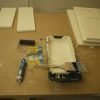



- Lightly sand the first finish coat and apply a second coat (optional)
Using very fine emery cloth or a sanding block, very lightly sand the dry first finish coat to remove any dust contamination or surface irregularities. Wipe clean with microfiber cloth and finish with tack cloth. You can wipe the surface one more time with a clean microfiber cloth dampened with mineral spirits. Then, using the same techniques as the first finish coat, apply a second finish coat and allow to dry.
- Polish the finish (optional)
I wanted a rather soft, matte finish, so after letting the final finish coat cure for several weeks, I very lightly polished the painted surface with polishing compound (Cyclo Industries No.7 white) and a soft cloth. I buffed the surface just to soften the finish and level the paint.
After polishing, I washed the doors thoroughly with soapy warm water. (Beware that this and many polishing compounds have a mild solvent odor that may take a few weeks to fade from the polished surfaces.)

- If painting cabinet bodies as well as the doors
If you are painting the doors and the cabinet bodies, follow the above sequence to paint the cabinet boxes in place. Tape off and cover walls, counters, appliances and anything else at risk of getting splattered with paint. Consider rolling or brushing on the primer instead of spraying if painting the cabinet bodies in place. You may want to alternate door painting with cabinet body painting during drying periods. Protect each area (door painting area and kitchen cabinet painting area) from sanding dust contamination from the other during prep periods.


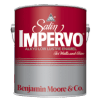
















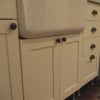

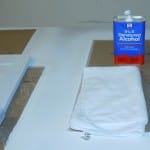



I have been a painting contractor for 30 years and from my view, you did an amazing job!! I always us benjamin Moore’satin impervo oil finish. nice job, We hang the doors then spray them.
Hi – I am reading this thread with interest and am based in the UK – can you tell me how your painted units have stood the test of time and being used everyday and knocked. Has any paint come off? and do they wipe down well.
Many thanks.
Hi Kerry,
The painted cabinets have held up well – no chips or paint loss. I do wipe them down with a damp cloth every few weeks, but otherwise they have been maintainence free and look as good as new!
Gary
Hi ,
Loved this post Painting Kitchen Cabinets . Sharing it on my Facebook and Pinterest profile.
Cheers
We are adding on a new great room and I am buying an Ikea kitchen and want to paint the cabinets myself. I want simple slab fronts (easy to clean, nothing to catch in crevices) so was thinking of buying the Veddinge (which may have taken the place of Applad) as it is described as MDF with painted finish. I am just going to paint the fronts and edges as my color is a pearl gray and white insides are fine as they only will show when open and will match the white interior. My questions is: does MDF hold up and would I follow the same or similar steps that you described for painting. I have only painted wood/plywood cabinets before and even with a not so careful job and using Behr paint they are holding up great and still looking fresh two years later. I just wipe them off to clean.
I looked into some of the make to order cabinets (semihandmade, schere(?) and Kokeena , but they are either fairly expensive and would either need professional painting or I still would have to paint, so am back to maybe using Ikea doors and painting them. Thoughts.
Hi Michelle –
Congrats on the new addition. As far as the Veddinge cabinet doors, from my quick read of the Ikea site, it sounds like they may be resin finished which may complicate your ability to paint them. From Ikea:
Product description
Fiberboard, Acrylic paint, Polyester paint
If they are finished with a polyester resin, you may have difficulty getting standard paints to stick to them. I would investigate with Ikea and maybe consider a different door. And yes, MDF holds up well and is very commonly used in cabinet construction and should paint well.
Good Luck!
Gary
They look fabulous. We too ended up with IKEA’s brown-black cabinets and wanted creamy white. Penitrol says that it is for exterior use ONLY. That’s usually because it isn’t safe to breathe the fumes in an enclosed space. Wasn’t there something that works for inside applications?
Hi Laurel,
Thanks!
I agree, I suspect the Penetrol warning is related to solvent off gassing as you suggest and maybe related to recent changes in U.S. VOC regulations. I know many use it for indoor painting. I did let my doors dry for several weeks (in the basement) before putting them up. I haven’t noticed any issues with odors, etc.
I did some searching and interestingly, I found this page from The Flood Company (the makers of Penetrol) Australia, endorsing its’ use indoors.
Thanks for the comments and using our site!
Gary
Hello, I am very impressed with how much time and care you took for this project. We chose IKEA Lidingo cabinets. My husband built and installed them. They turned out amazingly as we also hired a contractor to do the finishing touches, electrical, plumbing and our crown moulding. Now after all of his hard work, I accidentally used an adhesive tape/hook which took off a square inch of finish on a top cabinet! This is a side panel and I’m wondering if I should cover the entire panel with paint, or just apply enough to “patch” the area? your advice would be greatly appreciated.!
Hi Lindola,
Thanks for using the site and congrats on your new kitchen!
Sorry to hear about your issue with the cabinet finish. I didn’t catch if you had them painted? If so, do you know what type of paint was used to finish the cabinets? If you could upload a photo of the damage, it may help myself and potentially other readers respond with some suggestions.
Without any information of the finish used, my first thought would be to first try and fill in any deficit caused by the finish removal. I would use some type of filler to bring the deficit flush and then finish with the same finish used on the cabinets. You would likely need to smooth the filler with graded sand paper finishing with something fairly fine (300 – 400). Be careful not to involve too large of area when sanding. You will need to “blend” the repair into the surrounding finish, but keep it as small as possible.
These are just some initial ideas. The best answers will rely on knowing more about the type of material the door is made of and the products used on it.
CDIY
Thank you for great tutorial, I am also planing to paint my Ikea doors. My question is : You mentioned above that you left the doors to dry for several week after applying the penetrol spiked impervo which you stated that it takes 48 hours to dry (part 10). Is it correct or is it a mistake ? Thank you for replying to me.
Hi Etty –
I allowed the Impervo coats (I used two coats of the Impervo) to dry for 48 hours prior to handling or recoating. This was enough time for the Impervo to be dry to the touch and allow me to flip the doors and paint the opposite sides and to apply a second coat. The paint needs additional time before it is entirely dry and has “cured”.
According to the Benjamin Moore website, Satin Impervo can be washed after two weeks. This is from their site:
Dry Time @ 77°F – To Touch 4 Hours
(25°C) @ 50% RH – To Recoat **Overnight
Painted surfaces can be washed after two weeks. High humidity and cool temperatures will result in longer dry, recoat and service times. ** If a second coat is required, allow an overnight dry, lightly sanding between coats. Under normal drying and curing conditions, Satin Impervo® reaches its final low lustre finish in five to seven days.
CabinDIY
Hi there, they look great! Thanks so much for the step-by-step instructions. We are about to paint our Tidaholm cabinets as well (like you, we bought them a few years ago intending to paint over them). How have the cabinets held up since you painted them? Any chips or peeling?
Hi Shirley,
Thanks for the comments. The cabinets have been in service for around two years and have held up very well. No chips, peeling or other issues with the paint. I would highly recommend the products we used and for sure would use them again.
I just saw your reply… Thanks so much – very reassuring! We will probably end up posting our painted cabinets on our occasional blog after we’re done (hopefully sometime in the next month or two, but I’ve also got to get my husband on board the time frame…), and when we do I will be sure to link to you. Thanks again!
Great, I would love to see your photos of the completed project.
Hi Ryan,
Thanks for the comments.
We would have preferred to purchase cabinets finished in our desired color, but the stock offerings at Ikea in white were laminated particle board or some type of plastic resin — we wanted a rustic wood door.
The Ikea oak Tidaholm doors seemed perfect, but were only offered in the dark brown-black that you see above.
So, we painted them. This also allowed us to get the exact color to match the rest of the interior.
Thanks for sharing your step-by-step instructions. I think it’s interesting that you purchased new cabinets and then decided to paint them. It’s not the most common approach but the cabinets turned out great!